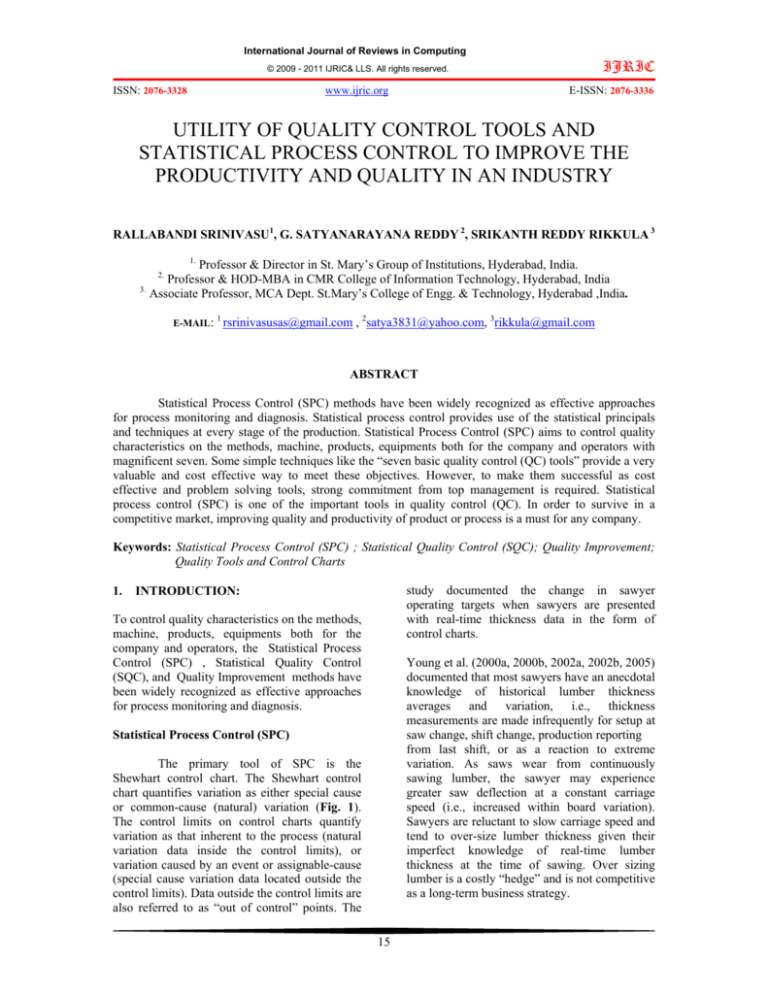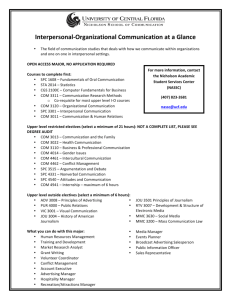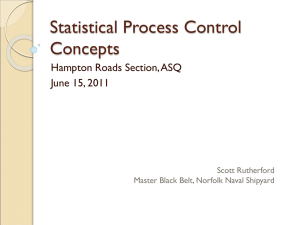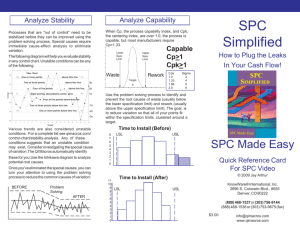
International Journal of Reviews in Computing
IJRIC
© 2009 - 2011 IJRIC& LLS. All rights reserved.
ISSN: 2076-3328
www.ijric.org
E-ISSN: 2076-3336
UTILITY OF QUALITY CONTROL TOOLS AND
STATISTICAL PROCESS CONTROL TO IMPROVE THE
PRODUCTIVITY AND QUALITY IN AN INDUSTRY
RALLABANDI SRINIVASU1, G. SATYANARAYANA REDDY 2, SRIKANTH REDDY RIKKULA 3
1.
Professor & Director in St. Mary’s Group of Institutions, Hyderabad, India.
Professor & HOD-MBA in CMR College of Information Technology, Hyderabad, India
3.
Associate Professor, MCA Dept. St.Mary’s College of Engg. & Technology, Hyderabad ,India.
2.
E-MAIL:
1
rsrinivasusas@gmail.com , 2satya3831@yahoo.com, 3rikkula@gmail.com
ABSTRACT
Statistical Process Control (SPC) methods have been widely recognized as effective approaches
for process monitoring and diagnosis. Statistical process control provides use of the statistical principals
and techniques at every stage of the production. Statistical Process Control (SPC) aims to control quality
characteristics on the methods, machine, products, equipments both for the company and operators with
magnificent seven. Some simple techniques like the “seven basic quality control (QC) tools” provide a very
valuable and cost effective way to meet these objectives. However, to make them successful as cost
effective and problem solving tools, strong commitment from top management is required. Statistical
process control (SPC) is one of the important tools in quality control (QC). In order to survive in a
competitive market, improving quality and productivity of product or process is a must for any company.
Keywords: Statistical Process Control (SPC) ; Statistical Quality Control (SQC); Quality Improvement;
Quality Tools and Control Charts
1.
study documented the change in sawyer
operating targets when sawyers are presented
with real-time thickness data in the form of
control charts.
INTRODUCTION:
To control quality characteristics on the methods,
machine, products, equipments both for the
company and operators, the Statistical Process
Control (SPC) , Statistical Quality Control
(SQC), and Quality Improvement methods have
been widely recognized as effective approaches
for process monitoring and diagnosis.
Young et al. (2000a, 2000b, 2002a, 2002b, 2005)
documented that most sawyers have an anecdotal
knowledge of historical lumber thickness
averages and variation, i.e., thickness
measurements are made infrequently for setup at
saw change, shift change, production reporting
from last shift, or as a reaction to extreme
variation. As saws wear from continuously
sawing lumber, the sawyer may experience
greater saw deflection at a constant carriage
speed (i.e., increased within board variation).
Sawyers are reluctant to slow carriage speed and
tend to over-size lumber thickness given their
imperfect knowledge of real-time lumber
thickness at the time of sawing. Over sizing
lumber is a costly “hedge” and is not competitive
as a long-term business strategy.
Statistical Process Control (SPC)
The primary tool of SPC is the
Shewhart control chart. The Shewhart control
chart quantifies variation as either special cause
or common-cause (natural) variation (Fig. 1).
The control limits on control charts quantify
variation as that inherent to the process (natural
variation data inside the control limits), or
variation caused by an event or assignable-cause
(special cause variation data located outside the
control limits). Data outside the control limits are
also referred to as “out of control” points. The
15
International Journal of Reviews in Computing
© 2009 - 2011 IJRIC& LLS. All rights reserved.
ISSN: 2076-3328
www.ijric.org
IJRIC
E-ISSN: 2076-3336
of research on SPC by Lowry and Montgomery
(1995), Woodall and Montgomery (1999) and
Stoumbos et al. (2000). Nevertheless,
conventional SPC methods are typically
restricted to a single process stage in industrial
and service applications.
Quality Control (QC) is an important function in
factory as it deals with product inspection before
the product was shipped to customers. Statistical
process control (SPC) is one of the tools widely
used in QC to monitor whether the production
process is in control through the use of statistical
control chart.
Many researchers have noticed the trend that
service quality improvement has become a
necessity in many industries. Wyckoff (1984)
claimed that SPC is a good method for service
managers to monitor service processes, and also
helpful for staff to conduct self-improvement.
Palm et al. (1997) also pointed out that SPC
would have great possibilities in service
industries, such as health care and education, and
has already been proven to be useful in
healthcare industry. The adoption of SPC into
service operations provides a huge opportunity
for service quality improvement. However, there
are also some obstacles to applying SPC in
services, such as what to measure and how to
measure. The main difference between a
manufacturing system and service system is that
customers are involved into service operations.
How to measure the customers’ perceived
quality is a challenge. Therefore, researchers
investigated modification of quality definition in
services (Lehtinen and Lehtinen, 1982;
Gronroos, 1983). One of the most popular
definitions was proposed by Parasuraman et al.
(1985). Service quality was defined as the extent
to which the service meets or exceeds customers’
expectations of it.
Figure 1. — Basic form of a control chart.
Statistical process control is used to describe the
variability that can be controlled or cannot be
controlled. This variability is also called
common cause or special cause. Common cause
occurs with the nature of the process. It exists in
all processes and it is the variability from the
system. Special cause is not the part of the
process. It exists almost all processes because of
some certain reasons. If there is not variability
because of special causes, that means the process
is statistically under control. For a process that is
statistically under control, the researcher can
conclude that, it has a definable identification
and a definable capability. In a process that is
under control, by removing all special causes
that are noticed until then, the remaining
variability would come from common causes.
After taking the process under control, the next
stage improves the process. The only target for
the production is to get the statistically control,
and to reduce the variables in the same time.
Because as the variables reduce, the cost is going
to be less, too.A large variety of Statistical
Process Control (SPC) schemes have been
developed for quality and productivity
improvement since the 1960s. SPC utilizes
statistical methods to monitor manufacturing
processes with an aim to maintain and improve
the product quality while decreasing the
variance. Much research has been conducted on
the issues of SPC and the resulting developments
are readily available in the literature, see surveys
Quality improvement program had been
designed and implemented to increase the
potential of making more profit. By improving
the quality, it also means improvement in
productivity and lower reject rate. Quality goals
can be included in the business plan and as a
degree of a product or service excellence
provided to customer. Quality improvement
should not only focused on external customer but
also its internal customer.
Parasuraman et al. (1988) identified five service
dimensions from their survey across industries
16
International Journal of Reviews in Computing
© 2009 - 2011 IJRIC& LLS. All rights reserved.
ISSN: 2076-3328
www.ijric.org
STATISTICAL QUALITY CONTROL:
•
•
•
•
•
•
Statistical Quality Control (SQC) is a
scientific method to analyze manufacturing data.
Based on this analysis, measures are taken to
maintain the quality of the manufactured
product. One of the techniques that are used to
monitor manufacturing processes and provide
feedback is Statistical Process Control (SPC).
The feedback is used to maintain and improve
the capability of the process and to ensure
product conformance. SPC is used to control the
process by signaling when adjustments may be
necessary. Some techniques associated with SPC
include frequency histograms and control charts.
A control chart is the tool used to monitor the
variation in a process and ensure that the process
is in a state of control. This allows the operator
to monitor the trends occurring in the process.
The control chart reflects the specification limits,
namely, the Upper Specification Limit (USL)
and the Lower Specification Limit (LSL). In
addition, it has upper and lower control limits
that lie within the specification limits. The Upper
Control Limit (UCL) and the Lower Control
Limit (LCL) are determined by evaluating the
dispersion (variability) in process, see Fig. 1. In
a well-controlled process, these limits can be
chosen to be equal to µ ± 3σ respectively, where
σ is the process standard deviation and µ is the
process mean. These statistical limits are
normally called the .3 sigma control limits.. In a
normal (Gaussian) distribution, 99.73% of the
values measured lie in interval of width 6 σ.
3.
E-ISSN: 2076-3336
at every stage of the production. In this manner,
statistical process control aims faithfulness to the
standards, provides the fitness of the
specifications that have been determined earlier.
It is used to reduce the defected products as
much as possible. Statistical process control is
powerful collection of problem-solving tools
useful in achieving process stability and
improving capability through the reduction of
variability. The company had used some of the
“seven basic quality control tools” in their
problem solving technique. The seven quality
tools are (Ishikawa, K. 1985). These tools, often
called magnificent seven are;
and developed the service quality measurement
scale called SERVQUAL, which has been a
widely used measurement scale of service
quality (Athanassopoulos, 1998; Lee et al., 2000;
Soteriou and Chase; 1998; Soteriou and Zenios,
1999). TOPSIS (Hwang and Lin, 1987) and Loss
Function (Ross, 1988) are also alternatives of
perceptual quality measurement. Besides the
perceptual measurement data of service quality,
Klassen et al. (1998) identified the operating data
of productivity, efficiency and effectiveness as
three of the most widely used indicators in
service operations.
2.
IJRIC
•
Check Sheet
Pareto Chart
Histogram
Scatter Diagram
Process Flow Chart
Cause and Effect Diagram or Fish
Bone Diagram
Control Chart
The control chart is perhaps the most widely
used of the “seven basic quality control tools”. It
is the key tools in statistical process control
(SPC) because it displays process behavior
graphically and it is used to monitor and control
processes within the specified control limits
(Bisgaard, S. 1993). There are two basic types of
control chart, depending on the type of data
collected; namely variable control chart and
attribute control chart. Variable control chart are
designed to control product characteristics and
process parameters which are measured in
continuous scale.
Examples of product characteristics are length,
weight, and diameter and examples of process
parameters are temperature, pressure, and PH
value (Freeman, J, G. Mintzas. 1999). The
primary variable control chart used are the X-bar
and R chart and moving range chart, while the
other two, rarely used charts include X-bar and s
chart and median chart ( Anjard, R.P. 1995 ).
Attribute control charts are designed to control
the process. Measurements used are in terms of
good or bad, accept or reject, go/no-go, or pass
or fail criteria (e.g. conforming or nonconforming) (Freeman, J, G. Mintzas. 1999).
The distinction between nonconforming or
defective unit and nonconformities or defects is
very important in attribute control chart because
QUALITY CONTROL TOOLS:
Statistical process control aims to produce
the products in the most economic and useful
way by using statistical principles and techniques
17
International Journal of Reviews in Computing
© 2009 - 2011 IJRIC& LLS. All rights reserved.
ISSN: 2076-3328
www.ijric.org
E-ISSN: 2076-3336
[9]. Ishikawa, K. 1985. What is Total
Quality Control. Prentice Hall. Englewood
Cliff, N.J.
it will determine the selection in the type of
attribute control chart used. A nonconforming or
defective unit, however, may fail to meet the
assessment criteria because of one or more
nonconformities or defects exist. For attribute
data, there are: p chart, np chart, c chart and u
chart. The p and np charts are the most widely
used. They are primarily used to monitor the
fraction of nonconforming unit, while, the c and
u charts are used to monitor the number of
nonconformities or defects. Wodall (Wodall, W.
H. 1997) discussed in detail the theory and future
research of attribute control chart.
[10]. J. Heizer and B. Render, .Operations
Management, 6th Ed., Prentice Hall, 2001.
[11]. Klassen, K.J., Russell, R.M. and Chrisman,
J.J. (1998) ‘Efficiency and productivity
measures for high contact services’, The
Service Industries Journal, Vol. 18, pp.1–
18.
[12]. Lee, H., Delene, L.M., Bunda, M.A. and
Kim, C. (2000) ‘Methods of measuring
health-care service quality’, Journal of
Business Research, Vol. 48, pp.233–246.
REFERENCES:
[1]. Anjard, R.P. 1995. SPC chart selection
process.
Microelectronic
Reliability.
35(11): 1445–1447.
[2].
IJRIC
[13]. Lehtinen, U. and Lehtinen, J.R. (1982)
Service Quality: A Study of Quality
Dimensions, Helsinki, Finland: Service
Management Institute.
Athanassopoulos, A.D. (1998) ‘An
optimization framework of the triad:
service capabilities, customer satisfaction
and performance’, in P.T. Harker and S.A.
Zenios (Eds). Performance of Financial
Institutions:
Efficiency,
Innovation,
Regulation, Cambridge, UK: Cambridge
University Press.
[14]. Lowry, C.A. and Montgomery, D.C. (1995)
‘A review of multivariate control charts’,
IIE Transactions, Vol. 27, pp.800–810.
[15]. MONTGOMERY, D.C., Introduction to
Statistical Quality Control, 3rd Ed., J.
Wiley, New York, P.677, 1996.
[3]. Bisgaard, S. 1993. Statistical Tools for
Manufacturing. Manufacturing Review.
6(3): 192–200.
[16]. Palm, A.C., Rodriguez, R.N., Spiring, F.A.
and Wheeler, D.J. (1997) ‘Some
perspectives and challenges for control
chart methods’, Journal of Quality
Technology, Vol. 29, pp.122–127.
[4]. D. Raheja, . Assurance Technologies:
Principles and Practices ., McGraw Hill,
Inc., 1991.
[17]. Parasuraman, A., Zeithaml, V.A. and
Berry, L.L. (1985) ‘A conceptual model of
service quality and its implications for
future research’, Journal of Marketing, Vol.
49, pp.41–50.
[5]. FARNUM, N.R., Modern Statistical Quality
Control and Improvement, Duxbury Press,
Belmont, California, p.500, 1994.
[6]. Freeman, J, G. Mintzas. 1999.
Simulating c and u Control Schemes. The
TQM Magazine. 11(4): 242–247.
[18]. R. T. Amsden, H. E. Butler, and D. M.
Amsden, . SPC Simplified: practical Steps
to Quality, Productivity, Inc. , 1998.
[7]. Gronroos, C. (1983) ‘Strategic management
and marketing in the service sector’, Report
No. 83-104, Marketing Science Institute,
Cambridge, MA.
[19]. Ross, P.J. (1988) Taguchi Techniques for
Quality Engineering, New York, NY:
McGraw-Hill.
[8]. Hwang, C.L. and Lin, M.J. (1987) Group
Decision Making Under Multiple Criteria:
Methods and Applications, Berlin:
Springer-Verlag.
[20]. Soteriou, A. and Zenios, S.A. (1999)
‘Operations, quality and profitability in the
provision
of
banking
services’,
18
International Journal of Reviews in Computing
© 2009 - 2011 IJRIC& LLS. All rights reserved.
ISSN: 2076-3328
www.ijric.org
IJRIC
E-ISSN: 2076-3336
statistical process control with wireless
measurement technology. Final Report for
Contract R112219-079. 152 pp
Management Science, Vol. 45, pp.1221–
1238.
[21]. Soteriou, A.C. and Chase, R.B. (1998)
‘Linking the customer contact model to
service quality’, Journal of Operations
Management, Vol. 16, pp.495–508.
[30]. Young, T.M. 1997. Process improvement
through “real-time” statistical process
control in MDF manufacture. Proc. No.
7281. In: Proceedings of Process and
Business Technologies for the Forest
Products Industry. Forest Products Society,
Madison, Wisconsin. pp. 50-51.
[23]. Stoumbos, Z.G., Reynolds, M.R., Ryan,
T.P. and Woodall, W.H. (2000) ‘The state
of statistical process control as we proceed
into the 21st century’, Journal of the
American Statistical Association, Vol. 95,
pp.992–998.
[31]. Young, T.M. 2000. Final report of project
titled, Electronic micrometer
interfaces
for human machine interface platforms in
hardwood lumber manufacture. The
University of Tennessee, Institute of
Agriculture
Faculty
Idea
Grant
R11221835/B11997401.
Unpublished
manuscript in preparation.
[24]. Wodall, W. H. 1997. Control Charts
Based on Attribute Data: Bibliography and
Review. Journal of Quality Technology.
29(2): 172–196.
[25]. Woodall, W.H. and Montgomery, D.C.
(1999) ‘Research issues and ideas in
statistical process control’, Journal of
Quality Technology, Vol. 31, pp.376–386.
[32]. Young, T.M. and P.M. Winistorfer. 1998.
Recovering more from your hardwood
lumber: reducing thickness variation. In:
Proc. of the 26th Annual Hardwood
Symposium (Technology and Market
Information for the Next Millennium).
National Hardwood Lumber Association.
Cashiers, North Carolina. pp. 109-120.
[26]. Wyckoff, D.D. (1984) ‘New tools for
achieving service quality’, Cornell Hotel
and Restaurant Administration Quarterly,
Vol. 25, pp.78–91.
[33]. Young, T.M. and P.M. Winistorfer. 1999.
Statistical process control and the forest
products industry. Forest Prod. J. 49(3):1017.
[27]. Young, T.M, B.H. Bond, C. Boston, J.
Wiedenbeck, R. James, and S. Morgan.
2002b. Tennessee Quality Lumber
Initiative (TQLI) Phase III: Reducing
lumber thickness variation and targets
using real-time statistical process control.
Final Report for Contract R112219-10,
U.S. Forest Service Contract R112218-089
and The University of Tennessee Special
Wood Utilization Grant R112218-054. 282
pp
[34]. Young, T.M., P.M. Winistorfer. and J.D.
Cox. 2000a. Tennessee Quality Lumber
Initiative (TQLI) – Phase I: reducing
lumber target sizes using real-time
statistical process control. Final Report for
Wood Utilization Special Research Grant
R112218-054. 124 pp.
[28]. Young, T.M, B.H. Bond, P.M. Winistorfer,
and J.D. Cox. 2000b. Statistical process
control for sawmills. In: Proc. of the 28th
Annual Hardwood Symposium. (West
Virginia Now-The Future for the
Hardwood Industry?). National Hardwood
Lumber Association. Canaan, West
Virginia. pp. 31-42.
[29]. Young, T.M, C.E. Pope, and S. Peskar.
2005. Tennessee Quality Lumber Initiative
(TQLI) Phase IV: Reducing lumber
thickness variation using real-time
19
International Journal of Reviews in Computing
© 2009 - 2011 IJRIC& LLS. All rights reserved.
ISSN: 2076-3328
www.ijric.org
IJRIC
E-ISSN: 2076-3336
ABOUT THE AUTHORS:
Rallabandi
Srinivasu
Srikanth Reddy Rikkula
Received his M.Sc Degree
from Nagarjuna University
Campus in 2000, M.Phil
degree
from
Acharya
Nagarjuna
University,
Guntur .in 2009.PGDTQM
degree from NIMSME in
2008. He is currently Pursuing Ph.D in
Management from Rayalaseema University,
India. Currently working as a Director in
ST.MARY’S Group of institutions, Hyderabad,
India. His main research interests are Data
Mining, Management Information Systems,
TQM, SIX SIGMA, SQC and Management.
Received his M.Sc Degree
from
Madras University,
Chennai in 2006. PGDBM
degree
from
Osmania
University, Hyderabad in 2010
He is currently Pursuing PhD
in Computer Science from
Rayalaseema University, India.
Currently working as Associate Professor at
St.Mary’s college of Engineering & Technology,
Hyderabad, India. His main research interests are
Data Mining, Management Information Systems,
TQM, SIX SIGMA, SQC and Network
G.
Satyanaraya
na
Reddy
Received his
MBA Degree
from Kakatiya
University in
1999,. He is
currently
Pursuing Ph.D in Management
from Rayalaseema University,
India. Currently working as HODMBA in CMRIT, Hyderabad,
India. His main research interests
are
Management Information
Systems (MIS) ,TQM, SIX
SIGMA, SQC and
Financial
Management.
20








